 |

Where to See it: Barrel Cactus grows on
rocky slopes and lower canyons around Borrego Springs. Little
Surprise Canyon and Glorietta Canyon are great places to see Barrel
Cactus.
Interesting Facts:
The spines of a cactus are actually modified
leaves. The main part of the plant is the stem.
Did you Know?
The spines of a cactus help to shade the green part of the plant from
the sun. A barrel cactus will get skinnier when there is little
water available and then plump back up when it has absorbed water.
These are all adaptations to help it survive.
Many animals eat the barrel cactus or its
fruit, including desert bighorn sheep and antelope ground squirrels.
It is also an important source of nectar for bees.
5 points in your Exploring Guide when you see this
plant! |
|
 |
|
Show me more!
| Hide
the answer
|
|
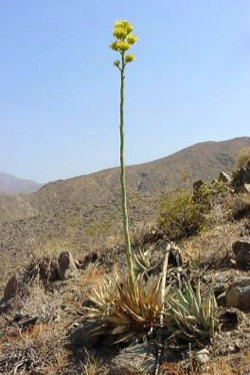 |

Where to See it: Desert Agave grows on
both the rocky slopes and flats around Borrego Springs. There are
also many agaves in the vicinity of Yaqui Pass, on the way from Borrego
Springs to Tamarisk grove.
Interesting Facts:
Sometimes the Agave is called a "century plant"
because it takes a really long time for the plant to bloom - up to 20
years! When
the stalk finally begins to grow, it can grow very rapidly, up to one
foot per day. It can reach a height of 15 feet.
Did you Know?
The Agave was an important source of food for native people, who ate the
flowers and cooked the leaves and stalks. They also used Agave as
a building material and to make footwear.
5 points in your Exploring Guide when you see this
plant! |
|
|
 |

What is an adaptation? An adaptation is something that a
plant or animal has developed over thousands of years to help it survive
in its environment and compete with other plants or animals. Here's an
example: The seeds of some desert plants have a hard coating on them
that must be worn off before the seed can grow. In most cases the hard
coating will only be worn off as the seed is tumbled around in the sand
during a flash flood. This adaptation works because the plant willp grow
only when there is also enough water to get it started. |
|
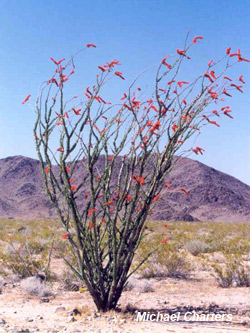 |

Where to See it: Ocotillo is a very
common plant in the Anza-Borrego Desert. It can be seen on the
well drained slopes around Borrego Springs.
Interesting Facts:
In some parts of the southwest Ocotillo branches
are planted in rows across the ground. Many of these branches will
take root and the result is a very dense living fence with
sharp spines!
Did you Know?
The Ocotillo spreads its roots out in all directions just below the
surface to absorb water whenever it rains. The Ocotillo sometimes
has no leaves and looks like a dead plant. But it is not dead at
all! As soon as there is some rain the branches will be covered
in bright green leaves.
The red tubular flowers are a favorite of
hummingbirds, which feed on the nectar.
5 points in your Exploring Guide when you see this
plant! |
|
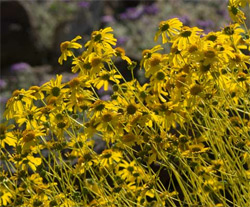 |

Where to See it: Brittlebush grows on
the rocky slopes, open sandy washes, and canyons west of Borrego
Springs.
Interesting Facts:
Brittlebush is an important food source for desert
bighorn sheep. Brittlebush is a member of the sunflower family.
Did you Know?
The leaves of the brittlebush plant have many very small hairs that give
it a silvery color. The hairs help to protect
the leaves from the heat of the sun and also to trap moisture and
prevent the leaves from drying out.
5 points in your Exploring Guide when you see this
plant! |
|
|

Why are there so many thorns?
The thorns on desert plants are an adaptation that serves several
purposes. First of all, they protect the stem, the main part of the
plant, and discourage animals from eating them! But some desert animals
eat them anyway. In the case of cactus, the thorns also form a shield
around the stem of the plant and give it some shade in the hot desert
sun. This is important because it keeps the plant from drying out.
Thorns also catch little drops of rain, when they fall, and channel all
that water down to the base of the plant. |
|
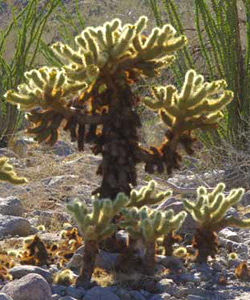 |

Where to See it: There are many
different kinds of cholla cactus that grow in different locations. Cholla may be seen from the desert floor up to the lower slopes of the
mountains.
Interesting Facts:
The fruit of the Cholla Cactus is a favorite food
of many desert animals.
Did you Know?
A Cholla Cactus may look fuzzy, but never touch it! Its spines are
extremely sharp and have barbs like fishhooks. It's painful to get stuck
by a Cholla. If an animal brushes up against a Cholla Cactus, a part of
the stem will break off and stick to the animal's fur. It will
eventually fall off, take root, and grow in the new location. This
adaptation helps the Cholla to reproduce.
5 points in your Exploring Guide when you see this
plant!
|
|
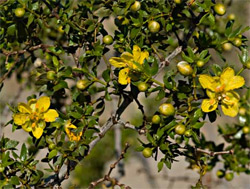 |
 Where
to See it: Creosote Bush is seen
throughout the Borrego Valley.
Interesting Facts:
Creosote Bush has tiny leaves with a waxy coating
that seals in the water and slows water loss. Its bright yellow
flowers become fuzzy white seed balls. The seeds are then easily
blown around in the wind to new locations, where new plants can start to
grow.
Did you Know?
Rub a leaf between your fingers and smell the aroma. When it rains
in the desert the air is filled with the scent of Creosote Bush.
5 points in your Exploring Guide when you see this
plant! |
|